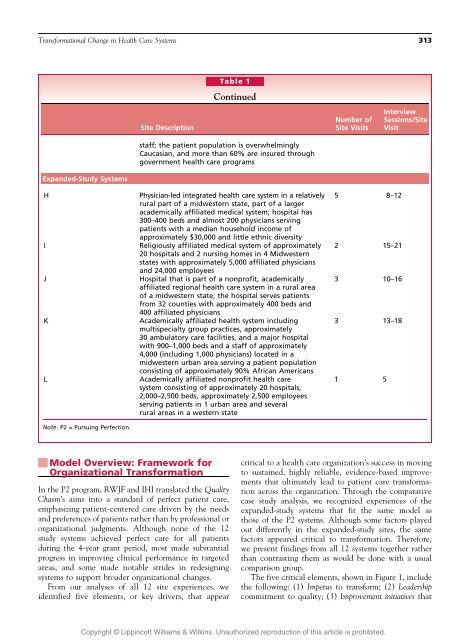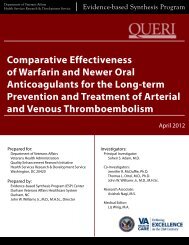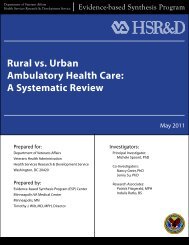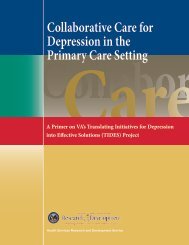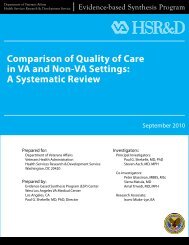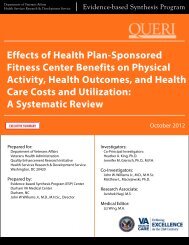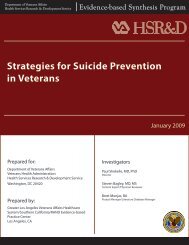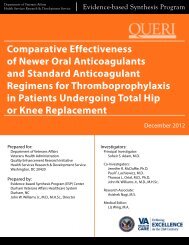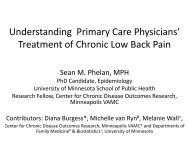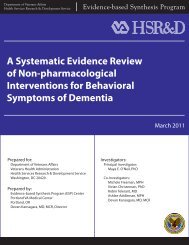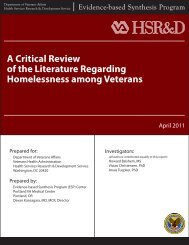VHA Systems Redesign; Transformational change in health care ...
VHA Systems Redesign; Transformational change in health care ...
VHA Systems Redesign; Transformational change in health care ...
Create successful ePaper yourself
Turn your PDF publications into a flip-book with our unique Google optimized e-Paper software.
<strong>Transformational</strong> Change <strong>in</strong> Health Care <strong>Systems</strong> 313<br />
Site Description<br />
Table 1<br />
Cont<strong>in</strong>ued<br />
Number of<br />
Site Visits<br />
Interview<br />
Sessions/Site<br />
Visit<br />
staff; the patient population is overwhelm<strong>in</strong>gly<br />
Caucasian, and more than 60% are <strong>in</strong>sured through<br />
government <strong>health</strong> <strong>care</strong> programs<br />
Expanded-Study <strong>Systems</strong><br />
H<br />
I<br />
J<br />
K<br />
L<br />
Note. P2 = Pursu<strong>in</strong>g Perfection.<br />
Physician-led <strong>in</strong>tegrated <strong>health</strong> <strong>care</strong> system <strong>in</strong> a relatively<br />
rural part of a midwestern state, part of a larger<br />
academically affiliated medical system; hospital has<br />
300–400 beds and almost 200 physicians serv<strong>in</strong>g<br />
patients with a median household <strong>in</strong>come of<br />
approximately $30,000 and little ethnic diversity<br />
Religiously affiliated medical system of approximately<br />
20 hospitals and 2 nurs<strong>in</strong>g homes <strong>in</strong> 4 Midwestern<br />
states with approximately 5,000 affiliated physicians<br />
and 24,000 employees<br />
Hospital that is part of a nonprofit, academically<br />
affiliated regional <strong>health</strong> <strong>care</strong> system <strong>in</strong> a rural area<br />
of a midwestern state; the hospital serves patients<br />
from 32 counties with approximately 400 beds and<br />
400 affiliated physicians<br />
Academically affiliated <strong>health</strong> system <strong>in</strong>clud<strong>in</strong>g<br />
multispecialty group practices, approximately<br />
30 ambulatory <strong>care</strong> facilities, and a major hospital<br />
with 900–1,000 beds and a staff of approximately<br />
4,000 (<strong>in</strong>clud<strong>in</strong>g 1,000 physicians) located <strong>in</strong> a<br />
midwestern urban area serv<strong>in</strong>g a patient population<br />
consist<strong>in</strong>g of approximately 90% African Americans<br />
Academically affiliated nonprofit <strong>health</strong> <strong>care</strong><br />
system consist<strong>in</strong>g of approximately 20 hospitals,<br />
2,000–2,500 beds, approximately 2,500 employees<br />
serv<strong>in</strong>g patients <strong>in</strong> 1 urban area and several<br />
rural areas <strong>in</strong> a western state<br />
5 8–12<br />
2 15–21<br />
3 10–16<br />
3 13–18<br />
1 5<br />
Model Overview: Framework for<br />
Organizational Transformation<br />
In the P2 program, RWJF and IHI translated the Quality<br />
Chasm’s aims <strong>in</strong>to a standard of perfect patient <strong>care</strong>,<br />
emphasiz<strong>in</strong>g patient-centered <strong>care</strong> driven by the needs<br />
and preferences of patients rather than by professional or<br />
organizational judgments. Although none of the 12<br />
study systems achieved perfect <strong>care</strong> for all patients<br />
dur<strong>in</strong>g the 4-year grant period, most made substantial<br />
progress <strong>in</strong> improv<strong>in</strong>g cl<strong>in</strong>ical performance <strong>in</strong> targeted<br />
areas, and some made notable strides <strong>in</strong> redesign<strong>in</strong>g<br />
systems to support broader organizational <strong>change</strong>s.<br />
From our analyses of all 12 site experiences, we<br />
identified five elements, or key drivers, that appear<br />
critical to a <strong>health</strong> <strong>care</strong> organization’s success <strong>in</strong> mov<strong>in</strong>g<br />
to susta<strong>in</strong>ed, highly reliable, evidence-based improvements<br />
that ultimately lead to patient <strong>care</strong> transformation<br />
across the organization. Through the comparative<br />
case study analysis, we recognized experiences of the<br />
expanded-study systems that fit the same model as<br />
those of the P2 systems. Although some factors played<br />
out differently <strong>in</strong> the expanded-study sites, the same<br />
factors appeared critical to transformation. Therefore,<br />
we present f<strong>in</strong>d<strong>in</strong>gs from all 12 systems together rather<br />
than contrast<strong>in</strong>g them as would be done with a usual<br />
comparison group.<br />
The five critical elements, shown <strong>in</strong> Figure 1, <strong>in</strong>clude<br />
the follow<strong>in</strong>g: (1) Impetus to transform; (2) Leadership<br />
commitment to quality; (3) Improvement <strong>in</strong>itiatives that<br />
Copyright @ Lipp<strong>in</strong>cott Williams & Wilk<strong>in</strong>s. Unauthorized reproduction of this article is prohibited.


